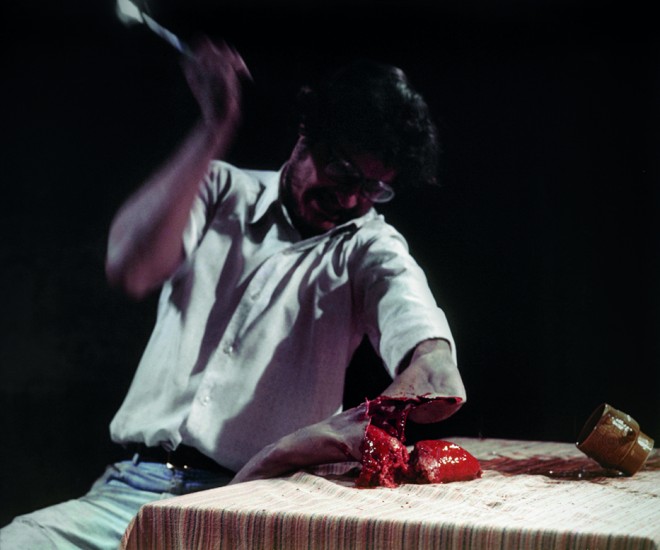Art, Amputations And Asylum Seekers: A Beginner’s Guide To Australian Rabble-Rouser Mike Parr
What would make someone pretend to hack their arm off in front of a live audience?


Inspired By The National Gallery Of Australia
This article was made possible by the National Gallery of Australia
–
The single word associated with virtually every piece of work produced by notorious Australian artist and veteran rabble-rouser Mike Parr is: “Why?”
Why would he pretend to hack off his left arm in front of live audiences, spilling mince and fake blood everywhere? Why would he hunker down in an isolated room for a week, with only water to keep him alive, broadcasting the experience live on the internet 24/7? Why would he sew his own eyes, lips and ears together? Why would he commit to non-stop smiling for 24 hours, pulling his facial muscles into the kinds of full-on contortions that would make Heath Ledger’s Joker admit “that dude’s hardcore”?
The Queensland-born septuagenarian has built a name for himself over the past four decades by staging the kind of performances where emergency services are briefed beforehand and anxious audiences are instructed not to wear open-toe shoes.
Now, a new exhibition, Foreign Looking, featuring a varied collection of his work is scheduled to run at the National Gallery of Australia. Open from August 12 to November 6, the exhibition will be separated into nine different rooms, each with a distinct look and feel. It includes never-before exhibited diaries, and works of photography and sculpture from the 1970s to present day. Knowing Parr, there’s a good chance he’ll be hiding behind one of his pieces, lurking like the creepy trench coat guy at the bus stop, ready to jump out and chase patrons around the room with a meat cleaver. Whether patrons would see the artistic merit in that or not is another question entirely.
Perhaps the biggest question surrounding Parr’s work is the extent to which his look-through-your-fingers provocations have depth, or are only that — provocations, arguably crude and self-indulgent. There are forces on both sides, pitchforks ready and intellectual arguments abound. But we are in a curious time in Australian art — perhaps, art more broadly — where that discussion no longer seems to matter, or at least is beside the point.
Reviewing a 2013 Sydney exhibition of Parr’s self-portraits for The Guardian, critic Andrew Frost reminisced on the long-time argy-bargy that has taken place between those who consider Parr’s work “profound narcissism” and those who defend it as a highfalutin practice “forged in expressionism and tempered by European late modernism.”
Frost arrived at a curious resolution: “both sides of Parr’s work turned out to be more or less correct”.
Parr’s art beckons to be considered seriously, not simply brushed aside as the work of a firebrand and a maniac. Although that’s unashamedly how he lures you in. The catch-22 of the work is that it’s geared towards knee-jerk responses — nothing if not disruptive — but by generating those responses, the medium tends to overtake the message.
Let us consider those kind of questions once more and this time, with an answer:
Why would Parr slop petrol over three-quarters of a million dollars’ worth of his prints then light them on fire in front of a crowd of 800 people? His reason: climate change. Before the bonfire the onlookers were given pieces of paper containing a series of key quotes from scientists such as Tim Flannery; the act was carried out with Talking Heads’ 1983 anthem ‘Burning Down The House’ booming overhead.
“The sheet I hand out makes it absolutely clear how drastic the situation is,” Parr said before the event. You could argue the extent to which he was effective in communicating that message, but it’d be something else entirely to argue there was no value in the discourse.
This is clearest in Parr’s strongest works. Returning to one of our original questions, Parr sewed his face together, in fact, in protest of asylum seeker detention centres. He claimed to be using his body art “to make the strongest possible statement in support of the detainees”.
That work, Close the Concentration Camps, took place all the way back in 2002, but it’s still incredibly resonant today. Maybe there is method to the madness.
–
Feature image: Still from Fresh Skin Like A Baby, 2010-2013, via ARNDT.
–
Luke Buckmaster is a film critic for Guardian Australia, Daily Review and contributes commentary to a range of Australian publications. He tweets at @lukebuckmaster.
–
Visit the Mike Parr exhibition Foreign Looking between 12 August – 6 November 2016 at the National Gallery in Canberra, entry is free.
